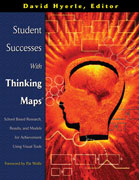



 dent Successes With Thinking Maps®
dent Successes With Thinking Maps®David Hyerle, editor with Sarah Curtis and Larry Alper co-editors
Chapter 17: Coaching and Supervising Reflective Practice
Kathy Ernst, M.S.
Until today, I had been dissatisfied with my ways of documenting classroom observations and sharing my data with teachers. At the beginning of each postlesson conversation, I would typically ask for the teacher’s input, with questions such as What stood out for you regarding the children’s work and thinking? What aspects of the lesson were you pleased with? Although I was often successful at building upon and deepening the discussion with references to the teacher’s observations and samples of children’s work, there existed an uncomfortable disconnect between my observations, written in the moment, and those of the teacher, recalled after the fact. Upon reflection, I discovered some interesting patterns in my work.
In spite of the fact that my classroom observations often yielded pages of descriptive and accurate accounts of meaningful dialogue and action, they were not readily accessible to me or anyone else. Whenever I needed to retrieve an anecdote that was relevant to my follow-up conversation with a teacher, the flow of our discussion was usually interrupted while I hurriedly scanned pages of my notes, searching for the “gem” I knew was buried somewhere between the mountains of lines. There sat the teacher, passively, while I sat in control of the data (after all, it was written in my own “chicken scratch”—who else could make sense of it?). Unfortunately, these awkward interruptions often caused anxiety in the teacher, giving rise to a cloud of tension that threatened to stifle our conversation.
Milo’s eyes widened as I laid out the flow map of the lesson on the table in front of us. He and I sat next to each other as I retold the story, pointing to each event as we went along. At times, it was Milo who deciphered my writing and joined in the storytelling. What amazed both of us was the ease with which we could retrieve events of the lesson and the comfortable, collaborative nature of this process. There was none of the anxiety or defensiveness that can often occur during the postobservation conversation. Instead, our focus was on the map in front of us, with its clear, descriptive evidence of the teaching and learning. In the future, after such a reading of the observation, I would more deliberately include the teacher by asking, “What’s missing? What would you like to add to the story?” I have since learned that the simple act of attaching the teacher’s observations to the flow map and including their story in the conversation creates a climate of trust, respect, and growth.
Read the complete chapter in the book Student Successes With Thinking Maps. Key sections from the chapter Mentoring Mathematics Teaching and Learning with excerpts above include:
- Tools For Focused Observation and Reflection
- Tools For Explicit Coaching In Model Lessons
- Part 1: Lesson Planning/Orientation
- Part 2: Lesson Observation
- Part 3 Reflective Conversation
- Imagining the Possibilities
Kathy Ernst, M.S. has spent 30 years teaching children and teachers in elementary and middle schools and has served on the faculty of the Leadership in Mathematics Education Program at Bank Street College of Education. She has facilitated the implementation of standards-based mathematics curricula in schools, working with teachers to support children’s construction of mathematical ideas.
![]() Click here (pdf file) to download Research Highlights from
Click here (pdf file) to download Research Highlights from
Student Successes With Thinking Maps
For more on Student Successes With Thinking Maps go to the following links: